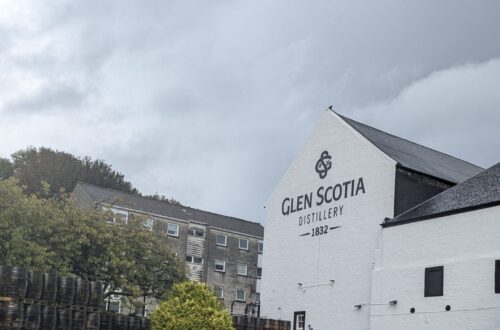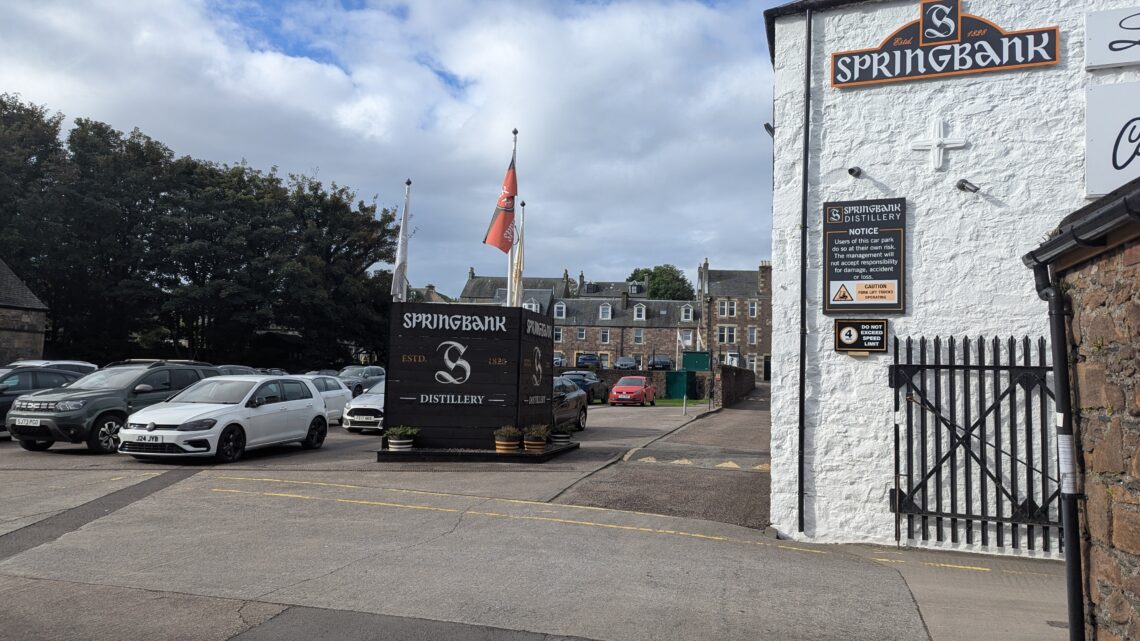
Campbeltown Day 2 (Springbank & Killkearn)
Itineary
09:45 – 10:45: Tour (Springbank: Standard)
11:15 – 12:15: Tour (Killkearn: Standard)
12:30 – 14:00: Wahback Bar
14:20 – 18:37: Bus (CityLink 926: Glasgow): Campbeltown – Glasgow Buchanan Bus Station
Today, I visited the two remaining distilleries in Campbeltown so that I could complete the full set! My first tour was booked at Springbank, which produces some of the most sought-after whisky in the world! Then my next tour was at the newest distilleries in the area, at Glengyle (Killkearn), which is right next door to Springbank. I booked on both morning tours, which match up pretty well, as you finish the Springbank tour in the shop, which is where you start the Killkearn tour, so it’s easy to combine them on the same day.
Springbank
Springbank produces some of the most sought-after drams on the market, and the tour is well-regarded for anyone passionate about whisky. There is a fantastic mixture of good whisky, authentic old-fashioned production style, and limited production of whisky, which combine to make Springbak exceptionally popular for whisky lovers. I admit I was a bit of a Springbank novice before I visited, so I was not quite aware of how popular the bottles are or how passionate people are about trying to get a bottle. However, I quickly understood the passion that people have for Springbank when I arrived early for my tour and saw the queue outside the distillery at 09:30 am. I initially thought the queue for the tour, but it turned out this was the queue of people waiting for the shop to open at 10 am so they could grab a bottle of Springbank either from the core range or the “cage”. The shop only puts around 8 bottles of 10-year-old and 1 bottle of 15-year-old out for sale each day, along with a selection of “cage” whiskies, which are a selection of special cask samples.
Apparently, the queues are a mix of whisky travellers and locals who often sell on the bottles for a profit (the 5-year-old I bought for £55 was available online for around £200). I have to say, despite their popularity, it is nice that bottles are still fairly reasonably priced in the shop if you can get your hands on one. The Springbank distillery shop had a distillery exclusive hand-filled bottle for £65, the 10-year-old was only £48 and 15 year old was £75 (if you can ever find any available). The shop does place a limit on bottle purchases, which means you can only buy one bottle from the core range per customer, and you are limited to one bottle of each of the bottles available in the shop. If you want a bottle of Springbank, the best bet and value is the hand-filled bottle from a demijohn in the shop. These are available for all the brands (Springbank, Hazelburn, Longrow, Killkearn) and contain a mix of different single malt finishes and ages, effectively a house blend of each single malt. The Springbank option was amazing, and probably the best whisky I tasted on my entire trip, and I was later informed that one of the whiskies rumoured to be in that one was a 30-year-old Springbank. I should note that there are plenty of bottles of the other whiskies produced at Springbank, such as Hazelburn and Longrow, which are both excellent single malts and again fantastic value for money.
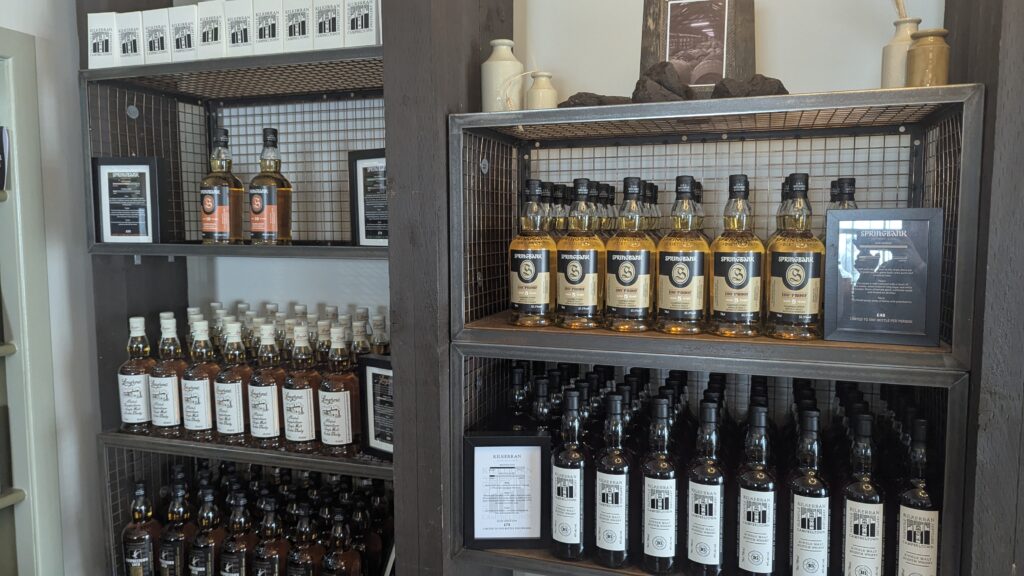
Tour
The Springbank tour has a reputation for being one of the best whisky tours available, and it did live up to the hype. The tour is ideal for someone with no whisky knowledge and for the whisky purists, as it takes you through the entire whisky production process and is a bit like a working museum with the old equipment and methods which are utilised. Springbank is the only distillery where the entire production process is completed on site, from barley to bottle. Although there are other distilleries which also do their own malting, this is the only one I am aware of where 100% of the malting process is completed on-site, and for a limited period each year, they even use local barley for the process. The tour began outside the shop with a brief history of Springbank. The distillery dates back to 1828, and it is a family-run business, which has avoided becoming part of a larger chain, and this is perhaps how they have kept old-fashioned and authentic methods still being used on site.
The first room on the tour is the malting floor, where you can see the barley spread out over the floor being prepared for the malting process. I purposely chose to visit during production so that I could see this process in action, as it is not something you see in many distilleries. After the malt room, the next stop is the kiln, where they have a huge stack of dried and wet peat, which is used to give Springbank its unique peaty flavour. The Kiln is used for some of the malts and for different lengths of time, as they produce lightly peated and heavily peated expressions. I can imagine it must be boiling in the summer as even with the kiln off, it was still very warm!
The next stop on the tour was the malt storage area, and the interesting thing here is that they have lots of different recipes for malting going on simultaneously as they produce three different single malts here (Springbank, Hazelburn and Longrow), each of which has its own unique production process. This means the staff have a lot to keep track of, and it’s a very scientific process involved in getting the peat just right as different temperatures and durations are applied depending on the whisky. Everything here is done by hand, as demonstrated by the “computer” which keeps track of which barley is for which whisky, which is basically a narrow blackboard with the number of the grain storage and single malt type written in chalk.
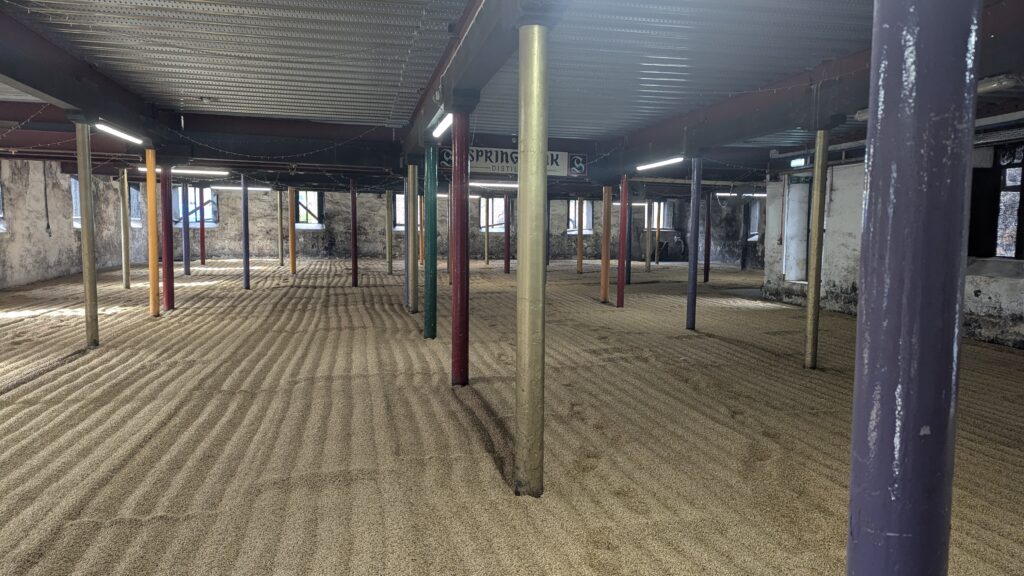
The next part of the tour was a visit to the mash tun, which is quite a sight! It is open top, bright red and is over 100 years old. This is indicative of all the equipment on site; it is very old and rustic, which adds to the authenticity of the whisky-making process, which occurs at Springbank. The Washbacks also look fairly worn, and I asked how often they get replaced, and I was told, “When they start leaking”. At Springbank, I think they live by the motto of if it is not broke, don’t fix it which seems to be working well for them. The stills are also well-worn but do look impressive, and opposite them, there was an excellent card on the wall which detailed how the whisky-making process differs between the single malts being produced at Springbank. its amazing how some subtle changes make a big difference to what is being produced. For instance, for Springbank Single Malt, they do 2.8 times distilled (although it’s listed as 2.5), Hazenburn is three times, and Longrow is twice distilled. One of the limitations of the manual processes being applied in Springbank is that production is only around 125k litres per year, and there is no scope currently to increase that, which is perhaps why they have a supply issue and high demand.

The final part of the tour is a small tasting where you get given a miniature bottle of Springbank (which is only available to people on the tour) to take home. You then get to sample one of the whiskies produced at the distillery, and are given a choice between the Springbank 10, Longrow heavily peated and Hazelburn. I opted for the Longrow single malt, which, even though it was heavily peated at 50-55ppm, you would not know it from the taste. It was very smooth, and only a hint of peat came through on the finish, not overpowering at all. I would say for me this was every bit as good as the Springbank options (except the hand-filled) that I tried, although their branding is not nearly as good! Quite a reasonable price in the shop too, at £50.
Killkearn
The Killkearn tour starts in the Springbank distillery shop, and I was doing the standard tour, which started at 11:15 am. The timing was perfect as I had time to complete the Springbank tour and then have some samples of the demin-john whisky options in the shop before I started the Killkearn tour. Although the distillery is a hundred yards or so from Springbank, there were some distinct differences in the processes being used between the sites. Killkearn was not in production when I was visiting, so it was quiet inside the distillery. The equipment is a lot newer than at Springbank, as Killkearn only reopened in 2004, so the equipment is still reasonably fresh. They also automate a lot of the whisky-making process at Killkearn, so they only have a couple of staff running the process. They actually only produce whisky for three months each year, between October and December, and they are only producing around 100,000 litres of whisky each year.
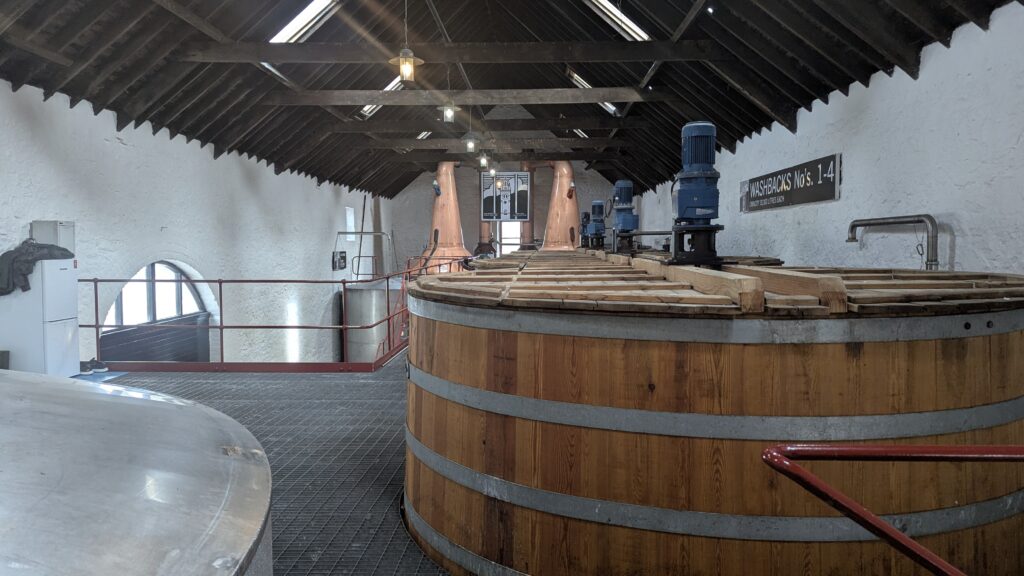
The tour of the distillery highlights the modest scale of production as the mash tun, washbacks and two stills are in the same room. The tour is contrasting to Springbank, in that they are very much making use of modern technology and methods for production, and the tour is maybe a little more basic, with less to see than at Springbank but they do produce some good stuff here. I was able to sample some of the new make spirit downstairs from the production room, and the nose was quite amazing with a strong scent of pears and apples and a very sweet tasting whisky, one of the most distinctive new make spirits I have tasted.
I also got to visit one of the palletised warehouses on site before heading onto the tasting, which takes place in the same area as the Springbank tour. On the tasting, I was given a miniature of Killkearn and then a choice of two drams to sample (peated or unpeated). I went with the peated and again I found it not overpowering in peat flavour, perhaps not quite as good as the Longrow, but still a very good whisky for me.
After the tasting, you exit into the Washback bar, which is a very nice place to enjoy a dram afterwards. I had some time before my bus, so I got a couple of drams at the bar, and the prices for Springbank malts are very reasonable, as I got a 15-year-old for £8 and the 10-year-old for £6. I got to try the core range 10 and a special edition 10, and I have to say I found the special edition a lot more interesting than the core range 10. The 15 was the most distinctive whiskey I tried; it had the atypical traits of Cambletown with some definite maritime influences of seaside salt and smoke. I can see why it is so popular!
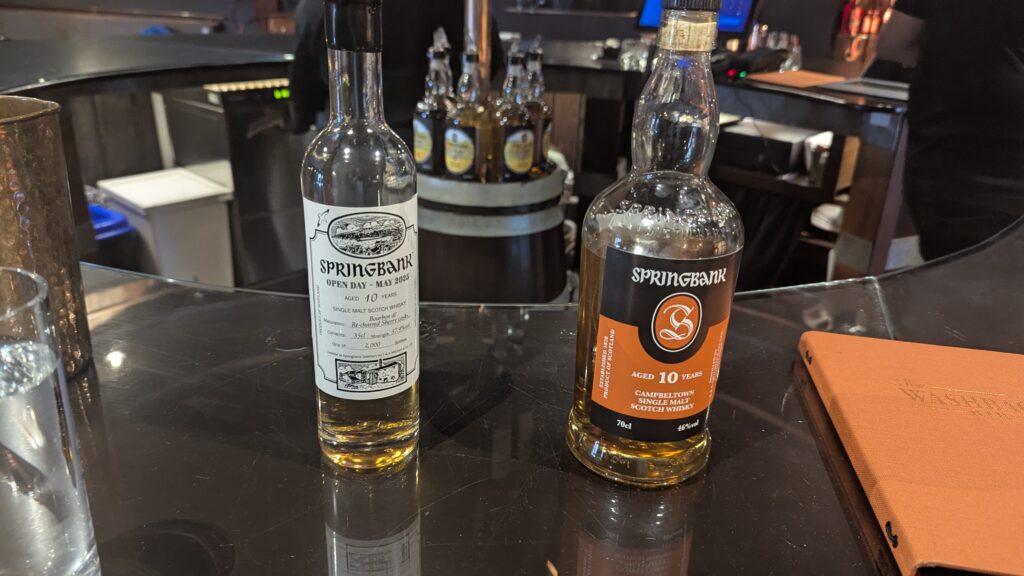
The journey home was a bit more straightforward as the road was fully open again, so it was just over 4 hours this time. Some of the views were fantastic too, as it was a sunny day, it was perfect for travelling. The bus took a short stop in Inverary, which was a beautiful little coastal town! Overall, it was a great trip to Campbeltown. The area is a true whisky town, and the people who visit tend to be whisky experts, and everyone seems to be passionate about whisky. I think I will definitely be back, the Springbank Barley to Bottle tour looks amazing (even at £250) and I would love to do that one day, although next time I might fly over first!


